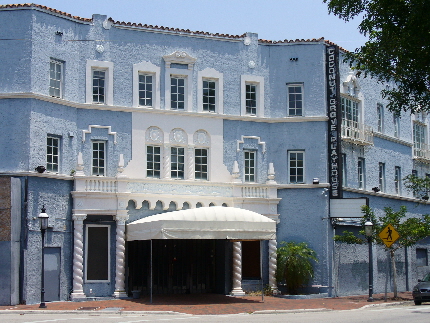 By Bill Hirschman
By Bill Hirschman
The resurrection of the Coconut Grove Playhouse is poised to take a major step forward Thursday afternoon, but precisely what that phoenix will look like when it rises is nearly guaranteed to remain blurry as different groups jockey for their vision to prevail in the long run.
A Miami-Dade County Commission sub-committee is slated to recommend contracting with a local architect to sketch out alternative configurations and then design a regional theater on the current site in the Grove business district.
The Economic Prosperity Committee is also set to recommend a 25-year agreement with the acclaimed GableStage from Coral Gables to operate a 300-seat theater no matter how the facility is designed.
Both proposals would go the County Commission in April for final approval, capping years of maneuvering to reopen the nationally-known theater that shuttered in a $4 million bankruptcy in 2006.
But a contentious battle among theater partisans, politicians, business leaders and preservationists will likely erupt Thursday during the public comments section of the meeting. Partisans on different sides have urged supporters to attend the 2 p.m. session at the Stephen P. Clark Center, 111 NW 1st St., Suite 220.
In one corner is a group represented by Michael Spring, senior advisor to the mayor and director of the Department of Cultural Affairs. He has been helming efforts to restore a nationally-recognized theater facility on the site of the deteriorating 1926 edifice ever since the playhouse’s non-profit board of directors locked the doors after 50 years in operation.
Spring and several others have worked hard to cobble together a deal with the property’s real owner, the State of Florida, to lease it back to the county. The deal would build a new theater with $20 million in previously earmarked bond money.
It would have an educational component run by Florida International University and GableStage would be the primary tenant in a 300-seat theater, perhaps with a parking garage operated by the city. That plays into some Grove residents’ hope for a continuing revitalization of the city as an entertainment and shopping mecca.
But as the project lurched closer to fruition, a new player arose last summer: Lewis “Mike” Eidson, a Grove resident, Coral Gables lawyer and longtime arts activist who currently serves as chairman of the Adrienne Arsht Center’s trust.
Eidson revealed that he and other wealthy arts activists incorporated as the Coconut Grove Playhouse Foundation. They had been quietly talking for months with scores of county residents and powerbrokers about a much more ambitious vision: A $45 million complex with a second 750-seat theater that would attract boldface-named stars and national producers to mount mainstream productions, much as the Grove did during its heyday.
He and his colleagues spent tens of thousands of dollars hiring consultants for an exhaustive study including the size of the potential audience, a detailed analysis of the cost of such a project and site plans, plus examinations of several other regional theaters around the country as a template.
Private donors would pay for the balance of the project not covered by the bond money, estimated between $25 and $35 million. A private non-profit group, perhaps the Arsht itself, would manage the complex with GableStage as a kind of tenant in the smaller space.
But complicating the issue, the foundation would raze what it considers a structurally unsound edifice (a much-debated contention) and build from scratch. The sole concession would be to either preserve the existing iconic Mediterranean-style façade for a new administration building or to rebuild a new one that resembles it closely.
That has enraged preservation-minded residents, many of them represented on Facebook by a group called Save the Coconut Grove Playhouse. The 1926 building has been cited as an architectural “expression of the Florida Land Boom… embodying the metaphoric Boom and Bust cycles that Florida has experienced, and continues as a signature building reflecting the heyday of Coconut Grove.” The City of Miami gave it historic preservation status in 2005. That means it cannot be altered or torn down without city approval. Edison notes that the whole building including the façade received a massive overhaul when the one-time movie house was turned into a legitimate theater in 1955.
The clash has resulted in public and private battles including Mayor Carlos Gimenez who staunchly supports Spring’s initiative but who has granted Eidson his blessing so long as it doesn’t endanger the forward motion of the current project and that it doesn’t cost taxpayers one more dime. Meanwhile, Commissioner Xavier Suarez, who chairs Thursday’s committee and represents the Grove, has floated a “memorandum of understanding” for the committee to consider that favors Eidson’s grander vision.
Some people say Eidson has said that GableStage’s artistic director Joseph Adler is too old at 74 to spearhead the move from a modest-sized company based at the Biltmore Hotel into a national-class regional theater at the Playhouse. Eidson denies he said such things. Eidson says he has no objection to GableStage operating the smaller theater so long as the overall administration of the structure – box office, utility bills, etc. – are handled by the umbrella organization. He said others’ concerns about Adler’s age do not concern him.
Spring and county officials say that Thursday’s proposed deal with Miami architect Arquitectonica International Corp. and Eidson’s vision are not incompatible. In fact, the existing multi-part charge to the architect is to first develop various scenarios including one with two auditoriums satisfying both Eidson and Adler. But most of the county’s discussions until the foundation went public focused primarily on a single smaller theater. More than a few observers worry that the foundation plan would slow down a long-awaited project that already is not expected to open for another five years.
County officials say the foundation will have to pony up about $4 million by the time the architect begins drawing up blueprints and then prove it has $25 million or more in cash on hand or a line of credit if the larger project is to go forward. If anyone can raise the funds, it’s likely the unfailingly upbeat and optimistic Eidson who has deep longstanding relations with wealthy and influential philanthropists and donors.
But there’s another hurdle: The State of Florida whose officials tired long ago of the Playhouse’s financial problems would have to sign off on the foundation’s larger plan which is more of an economic gamble.
The bottom line is that the foundation plan has to gell quickly without slowing down the county’s project, otherwise, the initial plan will go forward.
Adding a little topspin to the discussion is the name of the actor Kevin Spacey. Eidson revealed late last year that he was trying to woo sometime Florida visitor Spacey into serving the project in any capacity, preferably as the full-time artistic director or managing director. Acclaimed actor/director Jose Ferrer served in that role at the Playhouse during the early 1980s. Spacey apparently was not eager to commit to the level of time and effort he invested in recent years when he revived the Old Vic Theatre in London as a hands-on on-site artistic director, Eidson said.
But Eidson said Wednesday afternoon that he had spoken to Spacey that day and reaffirmed Spacey’s interest in serving as a consultant actively and deeply involved in working on a wide array of details of the theater. Spacey could not be contacted for comment.
The push and pull has led to some uncomfortable moments among the players, all of whom have long expressed admiration and support for each other. Eidson is a respected and well-liked civic leader especially in the arts. Adler is one of the most revered theater figures in the state. Spring has been lauded for decades of work evolving Miami-Dade into an international destination hub for the arts.
Some people have been critical of the county’s seeming reluctance to consider Eidson’s innovative vision. Others have said that Eidson is unrealistic and, in any case, has entered the process far too late to avoid endangering something being built at all. Eidson challenges that this is a perfect opportunity for Miami-Dade to take its place as an internationally-renowned destination for theater.
The Playhouse has been closed since 2006 – its 50th anniversary season. That invalidated the Playhouse’s lease with the state, which had taken ownership of the property in 1980.
Starting out as a movie theater in 1926, the building has played a major role in Florida cultural history. The edifice on the southwest corner of the Coconut Grove business/entertainment district has been repeatedly remodeled under several ownerships while becoming one of the nation’s leading regional theaters that emerged after World War II. Producers like Zev Buffman, Robert Kantor, Jose Ferrer and, after 1985, Arnold Mittelman mounted their own shows, hosted national tours and even provided a home for works being developed for Broadway.
The shows and the performers reflected a time when fading stars and supporting actors in film and television were able to headline major stage productions that they would never have the chance to attempt in New York. Some were triumphs and many were flops. Some were unadventurous fare; others reflected the latest thought-provoking hit from Broadway. In a few cases, Broadway-bound productions were developed at the Playhouse.
Among the legendary productions was the first American version of Waiting For Godot, starring Tom Ewell and Bert Lahr, an evening that left many playgoers confused because it wasn’t the comedy those stars were usually seen in.








 A PaperStreet Web Design
A PaperStreet Web Design
